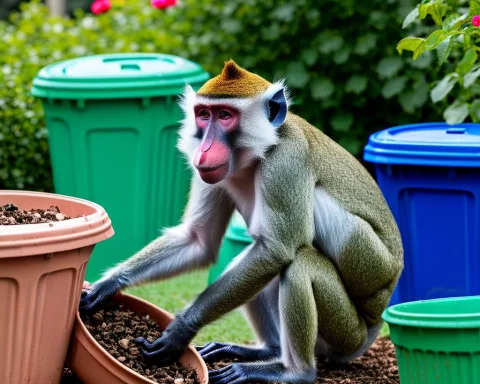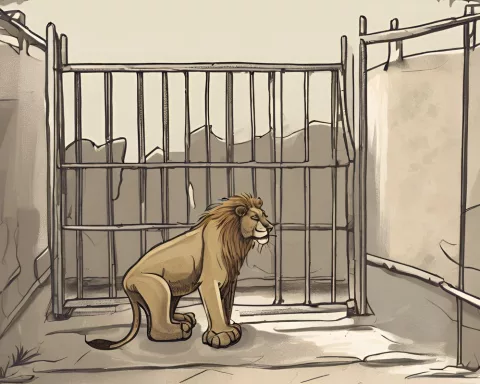The incident of a baboon visiting a restaurant in Cape Town highlights the complex relationship between humans and urban wildlife. It is essential to have responsible interactions with animals and maintain respect and awareness. Guidelines for responsible wildlife interaction include respecting animals’ personal space and natural behavior, maintaining a secure distance, and refraining from feeding or close contact for the purpose of taking selfies. Our city spaces are deeply interconnected with wildlife habitats, and a balanced and sensitive approach is necessary for coexisting safely.
What can we learn from an unexpected baboon encounter at a restaurant in Cape Town?
The incident at the Black Marlin Restaurant highlights the complex dynamics between humans and urban wildlife. It is important to have responsible interactions with animals and maintain a sense of respect and awareness. Guidelines for responsible wildlife interaction include respecting animals’ personal space and natural behavior, maintaining a secure distance, and refraining from feeding or close contact for the purpose of taking selfies. Our city spaces are deeply interconnected with wildlife habitats, and a balanced and sensitive approach is necessary for coexisting safely.
An Unusual Dine and Dash
The tranquil scenery of Miller’s Point, located to the south of Simon’s Town, played host to an unexpected guest. A baboon sauntered into the Black Marlin Restaurant, a well-frequented dining spot lauded for its breathtaking views. This unforeseen incident, recorded and shared widely, stirred an array of responses among the restaurant-goers, shedding light on the complex dynamics between humans and urban wildlife.
The video clip presents the baboon, seemingly indifferent to the spectators, helping itself to the forgotten dishes on the tables. The creature’s daring behavior elicited a spectrum of responses from the onlookers. One woman, in her effort to unseat the baboon, lobbed a dish of food at it, and endeavored to retrieve an item from its grasp. This move triggered a chain reaction among the other patrons, who began to launch an impromptu attack using water pitchers and beverages against the uninvited diner.
Amidst the ensuing chaos, a voice of sanity surfaced, promoting calmness and advising the crowd to stay still. Similar pleas for restraint were voiced by other alarmed spectators, imploring the agitated crowd to evacuate the area. However, their appeals for moderation mostly fell on oblivious ears.
Unfolding Drama in Urban-Wildlife Interface
As the baboon continued its unexpected restaurant tour, a group effort took shape to slowly withdraw, with the intention of guiding the baboon towards the exit. This episode not only underscored the intriguing, albeit unforeseen, convergence of urban and natural habitats but also highlighted the necessity for thoughtful reactions in such unpredictable circumstances.
In light of the incident, the Black Marlin management released a statement emphasizing their compliance with a rigorous SANPark-approved wildlife management strategy. The restaurant, nestled within a natural park, is familiar with unsolicited visits from Simon’s Town’s baboon population.
The measures they have in place include ongoing awareness programs for their service staff, setting up fences, and appointing watchers to monitor potential baboon intrusions. In case of wildlife encounters, the staff is trained to aid in the animals’ removal without inflicting any harm. Diners are dissuaded from engaging, threatening, or intimidating the baboons, thereby ensuring the safety of both the patrons and the animals.
Guidelines for Responsible Wildlife Interaction
The NCC Environmental Services, in collaboration with the Animal Welfare Society, has shared an extensive set of guidelines for responsible interaction with baboons. These principles underline the necessity to respect the animals’ personal space and natural behavior.
It is strongly advised against feeding baboons for the sake of capturing the ‘perfect shot’ considering its legal implications that includes hefty fines and potential jail time. Other prudent recommendations that are emphasized include maintaining a secure distance of at least 15 meters from baboons, staying inside vehicles during roadside encounters, and abstaining from close contact for the purpose of taking selfies.
A Cautionary Tale and a Lesson for Humanity
The incident at the Black Marlin Restaurant unfolds as a warning tale about the erratic nature of encounters with urban wildlife. It stresses the significance of sustaining a sense of respect and awareness when in close quarters with these animals.
The narrative of the baboon at the restaurant extends beyond the incident, serving as a metaphor for our broader interactions with urban wildlife. It highlights the need for a balanced and sensitive approach, an appreciation for the animals’ natural behavior, and a recognition that our city spaces are deeply interconnected with their habitats. As we traverse these shared spaces, maintaining a keen awareness of safety protocols and demonstrating a sense of respect for the wildlife are not mere suggestions, but critical necessities.
What does the incident at the Black Marlin Restaurant teach us about the relationship between humans and urban wildlife?
The incident at the Black Marlin Restaurant highlights the complex dynamics between humans and urban wildlife. It reinforces the importance of having responsible interactions with animals and maintaining a sense of respect and awareness. Guidelines for responsible wildlife interaction include respecting animals’ personal space and natural behavior, maintaining a secure distance, and refraining from feeding or close contact for the purpose of taking selfies.
What can we learn from the responses of the restaurant-goers during the incident?
The responses of the restaurant-goers during the incident demonstrate the need for thoughtful reactions in unpredictable circumstances. While some individuals reacted impulsively, others advocated for calmness and restraint. It is important to remember that animals, like baboons, are unpredictable, and it is our responsibility to act responsibly to ensure the safety of both the patrons and the animals.
What measures does the Black Marlin Restaurant have in place to prevent unsolicited visits from baboons?
The Black Marlin Restaurant complies with a rigorous SANPark-approved wildlife management strategy, which includes ongoing awareness programs for their service staff, setting up fences, and appointing watchers to monitor potential baboon intrusions. In case of wildlife encounters, the staff is trained to aid in the animals’ removal without inflicting any harm. Diners are dissuaded from engaging, threatening, or intimidating the baboons, thereby ensuring the safety of both the patrons and the animals.
What are the guidelines for responsible wildlife interaction with baboons in Cape Town?
The NCC Environmental Services, in collaboration with the Animal Welfare Society, has shared an extensive set of guidelines for responsible interaction with baboons. These guidelines emphasize the necessity to respect the animals’ personal space and natural behavior, maintain a secure distance of at least 15 meters from baboons, stay inside vehicles during roadside encounters, and abstain from close contact for the purpose of taking selfies. It is also strongly advised against feeding baboons for the sake of capturing the ‘perfect shot’ considering its legal implications that includes hefty fines and potential jail time.
What is the significance of the incident at the Black Marlin Restaurant beyond the incident itself?
The incident at the Black Marlin Restaurant serves as a metaphor for our broader interactions with urban wildlife, highlighting the need for a balanced and sensitive approach, an appreciation for the animals’ natural behavior, and a recognition that our city spaces are deeply interconnected with their habitats. As we traverse these shared spaces, maintaining a keen awareness of safety protocols and demonstrating a sense of respect for the wildlife are not mere suggestions, but critical necessities.
What is the key takeaway from the incident at the Black Marlin Restaurant?
The incident at the Black Marlin Restaurant emphasizes the need for responsible interactions with animals and maintaining a sense of respect and awareness. Guidelines for responsible wildlife interaction include respecting animals’ personal space and natural behavior, maintaining a secure distance, and refraining from feeding or close contact for the purpose of taking selfies. Our city spaces are deeply interconnected with wildlife habitats, and a balanced and sensitive approach is necessary for coexisting safely.












